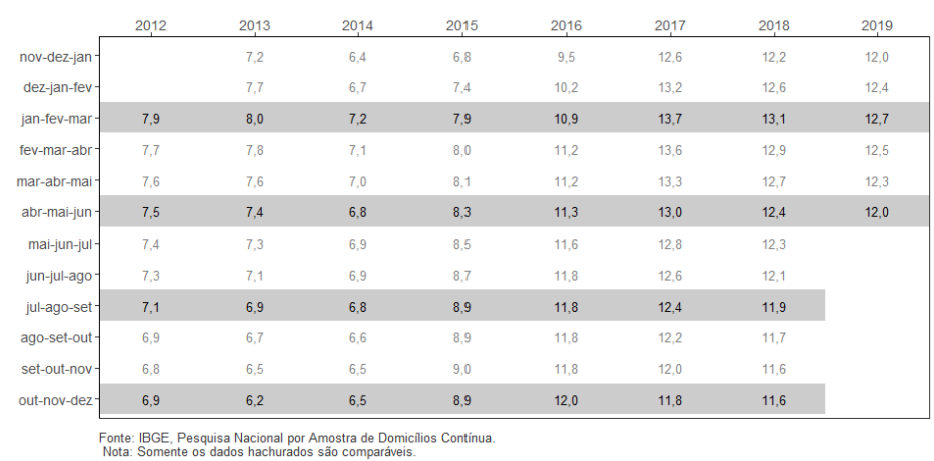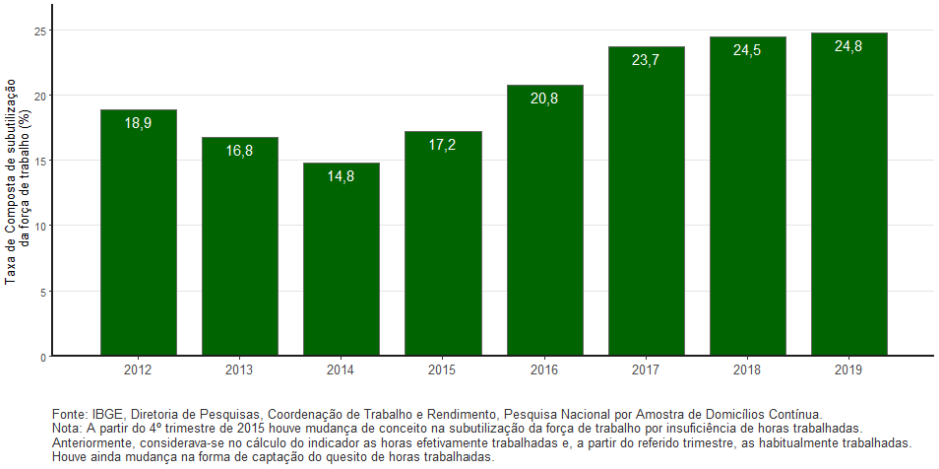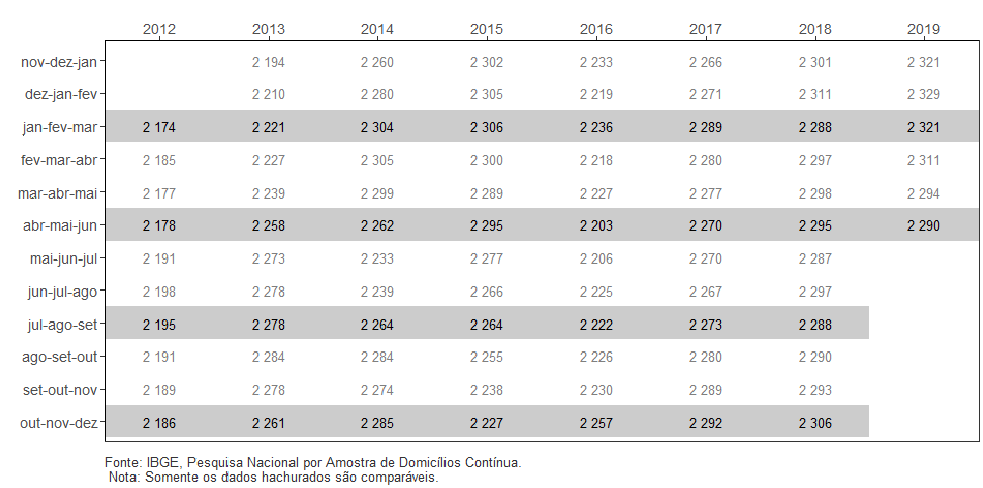Continuous PNAD: unemployment rate is 12.0% and underutilization rate hits 24.8% in quarter ended June 2019
July 31, 2019 09h00 AM | Last Updated: July 31, 2019 12h40 PM
In the quarter ended June 2019, the unemployment rate (12.0%) decreased by 0.7 percentage points (p.p.) against the January-March quarter in 2019 (12.7%) and by 0.4 p.p. against the same quarter a year ago (12.4%).
| Indicator / Period | Apr-May-Jun 2019 | Jan-Feb-Mar 2019 | Apr-May-Jun 2018 |
|---|---|---|---|
| Unemployment rate | 12.0% | 12.7% | 12.4% |
| Underutilization rate | 24.8% | 25.0% | 24.5% |
| Usual real earnings | R$2,290 | R$2,321 | R$2,295 |
| Change of the usual real earnings in relation to: | -1.3% (decrease) | -0.2% (stablity) | |
The unemployment rate (12.8 million persons) decreased (-4.6%, about 621 thousand persons searching for work) versus the previous quarter and was statistically stable against the same period in 2018.
The employed population (93.3 million persons) increased in both comparisons: 1.6% (1,479 persons more) against the previous quarter and 2.6% (2,401 thousand persons) in comparison with the same period in 2018.
The population out of the workforce (64.8 million persons) decreased in both comparisons: by -0.8%, or 494 thousand persons, against the previous quarter and by -1.0%, or 621 thousand persons against the same quarter in the previous year.
The labor underutilization compound rate (24.8%) did not record statistically significant changes against either the previous quarter (25.0%) or the same quarter in 2018 (24.5%).
The underutilized population (28.4 million) did not record statistically significant changes against the previous quarter and inccreased 3.4% (by 923 thousand persons) against the same quarter in 2018.
The number of discouraged persons (4.9 million) did not change significantly in either comparison. The percentage of discouraged persons in the workforce or discouraged population was 4.4%, repeating the record in the series and remaining stable in both comparisons.
The number of persons employed with a formal contract in the private sector (except domestic workers) was 33.2 million persons, with an increase in both comparisons: 0.9% (or 294 thousand persons) against the previous quarter and 1.4% (or 450 thousand persons) against the same period in 2018. The number of persons employed without a formal contract in the private sector (11.5 million persons) also increased in both comparisons: 3.4% (376 thousand persons) against the previous quarter and 5.2% (565 thousand persons) versus the same quarter in 2018.
The number of self-employed workers (24.1 million) hit a new record in the time series and recorded increases in both comparisons: 1.6% (391 thousand persons) against the previous year and 5.0% (1,156 thousand persons) against the same period in 2018.
The average usual real earnings (R$ 2,290) fell by 1.3% against the previous quarter and did not record significant changes against the same quarter in 2018. The real usual wage bill (R$ 208.4 billion) was stable in relation to the previous quarter and increased 2.4% (R$ 4.8 billion) against the same period in 2018.
Unemployment Rate - Brazil - 2012/2019
The unemployment rate was estimated at 12.0% for the moving quarter April -June 2019 and fell by 0.7 percentage points (p.p.) against the quarter January-March 2019 (12.7%). In comparison with the same moving quarter in 2018, when the rate was estimated at 12.4%, there was also decrease (-0.4 percentage points).
In the mobing quarter April-June 2019, there were approximately 12.8 million unemployed persons in Brazil. That figure fell (by -4.6%, or 621 thousand persons searching for a job) against the previous quarter and was ststistically stable versus the same period in 2018.
The labor underutilization compound rate was estimated at 24.8% in the moving quarter April-June 2019 and did not change statistically in either comparison: January-March 2019 (25.0%) or in the same moving quarter in 2018 (24.5%).
Compound labor underutilization rate – quarters from April to June - 2012/2019 Brazil (%)
The number of utilized persons in Brazil reached 28.4 million in the quarter April-June 2019, without significant change against the quarter January-March 2019. In comparison with the same quarter in 2018, that estimate increased 3.4%, or 923 thousand underutilized persons.
The number of time-related underemployed persons reached about 7.4 million in the quarter April-June 2019, a record in the time series. There was an increase of 8.7% in relation to the previous quarter, or 587 thousand underemployed persons. Against the same quarter a year ago, there was an increase of 13.8%, which is equivalent to 892 thousand underemployed persons more.
The potential workforce, in the quarter, in the quarter April-June 2019, was estimated at 8.3 million persons and remained stable in both comparisons.
Persons out of the workforce, in the quarter April-June 2019, reached 64.8 million persons, with decreases in both comparisons: -0.8% (or 494 thousand persons) against the previous quarter and -1.0% (or 621 thousand persons) against the same quarter in 2019.
The number of discoiraged persons was estimated at 4.877 million in the quarter March-May 2019. there was stability in both comparisons. The percentage of discouraged persons in the working or discouraged population was estimated at 4.4% and repeated the record of the time series, remaining stable in both comparisons.
The workforce (employed and unemployed persons), in the quarter April-june 2019, was estimated at 106.1 million persons. That population had an increment of 858 thousand persons (0.8%), against the previous year. Versus the same quarter in 2018, there was an increase of 2.2% (2.2 million persons more).
The employed population was estimated at approximately 93.3 million. There were decreases in both comparisons: from 1.6% (1,479 thousand persons) in relation to the previous quarter and 2.6% (2,401 thousand persons) against the same quarter in 2019.
The employment-population ratio (percentage of employed persons in the population at working age) reached 54.6% in the quarter April-June 2019 and increased in both comparisons: 0.8 p.p. against the previous quarter and 0.9 p.p. versus the same quarter in 2018.
The number of workers with a formal contract in the private sector (except domestic workers), estimated at 33.2 million persons, increased in both comparisons: 0.9% (or 294 thousand persons) against the previous quarter and 1.4% (450 thousand persons) against the same quarter a year ago.
The number of workers without a formal contract in the private sector (11.5 million persons) also increased in both comparison: 3.4% (an increment of 376 thousand persons) in comparison with the previous quarter and 5.2% (565 thousand persons more) in comparison with the same quarter a year ago.
Self-employed workers amounted to 24.1 million, the record in the time series. Both comparisons recorded increase: 1.6% (391 thousand persons more) versus the previous quarter and 5.0% (1.2 million persons more) versus the same quarter in 2018.
Employers amounted to 4.4 million, without significant changes in either comparison.
The number of domestic workers, estimated at 6.3 million persons, increased 2.4% in relation to the previous quarter and was stable in comparison the same quarter in 2018.
The group of persons employed in the public sector (including civil servants and the military), estimated at 11.7 million persons, recorded an increase of 2.6% against the previous month. There was no statistically significant change versus the same quarter in 2018.
The average monthly usual real earnings from all jobs of the employed population was estimated at R$ 2 290 in the quarter April - June 2019, with a decrease of 1.3% against the previous quarter and stability in relation to the same quarter a year ago.
The usual real wage bill of the employed population, in the moving quarter April-June 2019, was R$ 208.4 billion reais. There was stability in relation to the previous quarter and an increase of 2.4% agains the same quarter in 2018. That means an increase of R$ 4.8 billion in the wage bill.
Average monthly usual real earnings from all jobs of employed persons, in the month of reference - Brazil - 2012/2019 - (R$)




